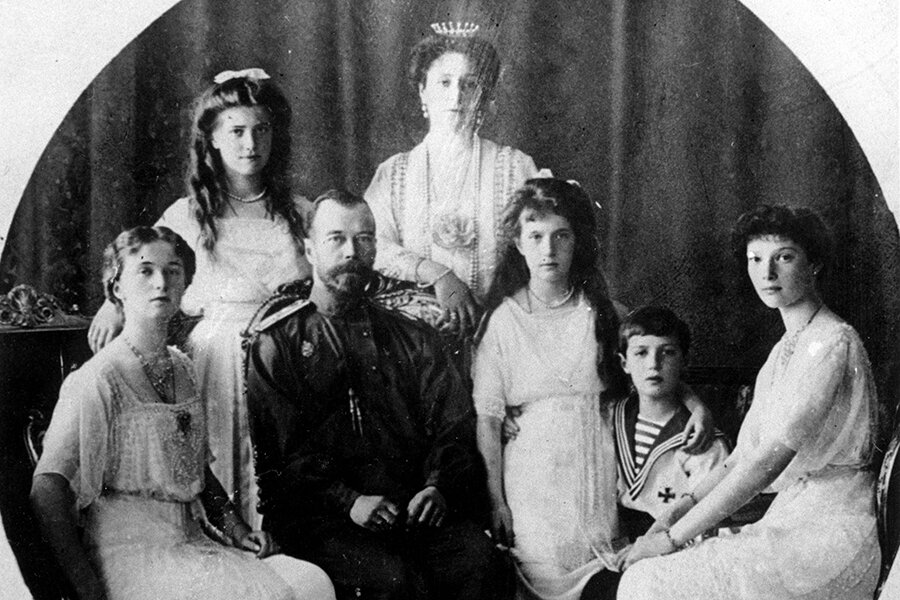Russian church-state mystery: Who is buried in Romanovs' tomb?
Loading...
| Moscow
The Kremlin's Investigative Committee, Russia's highest law enforcement body, is hot on the heels of a murder mystery.
No, it's not the assassination of opposition leader Boris Nemtsov earlier this year, nor any of the other unsolved post-Soviet killings that still haunt Russian politics.
Rather, it's a far older case, and one that many had thought solved: Are the remains identified as those of the last Romanov czar and his family, who were slaughtered by the Bolsheviks in 1918, indeed who they are said to be?
Curiouser is the force behind the inquiry, as historians say the issue has been long since settled to their satisfaction and polls suggest the public doesn't care about the case. Rather, it's the powerful Russian Orthodox Church which remains stubbornly unconvinced of the authenticity of the remains of Nicholas II, his wife, and their five children.
No one is sure why the church is so insistent. But at its request, Russia's top investigators are using modern DNA techniques to try to conclusively prove that remains dug out of a pit near Yekaterinburg after the demise of the USSR, are the Romanovs.
The Romanov mystery
The former czar, czarina, and three of their daughters were buried with great pomp in the Romanov crypt in St. Petersburg in 1998. The Kremlin had planned to bury the last two family members, the princess Maria and the crown prince Alexei, whose bones were retrieved in 2007, at a gala ceremony in St. Petersburg this month. Surviving members of the Romanov family were scheduled to attend, along with current Kremlin and church leaders.
But the church slammed on the brakes, and demanded conclusive proof that the remains of the late czar and his family – who were canonized by the church in 2000 – are genuine. The ceremony is now on hold until next February.
There have long been rumors that at least some of the Romanovs survived the massacre. The legend of Anastasia, Nicholas' youngest daughter, has been recycled constantly over the past century, including as a Hollywood animated movie.
Last month the Investigative Committee took DNA samples from Nicholas and his grandfather Alexander II from the family vault in St. Petersburg's Peter and Paul Cathedral. This week they announced that Nicholas' father, Alexander III, will also be exhumed to gather more genetic evidence for the widening probe.
According to the daily Moskovsky Komsomolets, the exhumation of Alexander alone will cost about $300,000 and could damage his ornate 19th century tomb.
Why now?
The church argues it's absolutely necessary to ascertain whose bones are in the crypt. "These people have been canonized, and if their remains are found they will be considered holy relics that believers will pray to, for this reason it’s very important to make sure," Father Vsevololod Chaplin, a church spokesman, told journalists last month.
No one knows why the church is being so obstinate about this – since hard DNA evidence has never been available for past saints – but there is no doubt that they are holding up a ceremony the Kremlin would like to finish with.
Some historians say it's enough. "We went through all this in the 1990s, with the participation of foreign scientists. The remains found near Yekaterinburg were found to be those of Nicholas and his wife," says Roy Medvedev, one of Russia's most venerable historians. "It's not clear what the church even wants. More scientific evidence? The church isn't known for its reliance on science in the first place. Do they expect a miracle? Let's just bury them and move on."
Experts say the Kremlin really would like to see the end of this controversy, but can't afford to offend the church, whose political support it has courted at the expense of secular society for years. The Kremlin has angered professional historians by closing museums and handing property, including dozens of famous churches, monasteries, and precious artifacts, back to the church for its own uses.
Digging up the past
The dispute also comes at a time when the Kremlin is courting members of the Romanov family, who have lived in exile since the Revolution.
Last week the presumptive heir to Russia's throne, Grand Duke Georgi Mikhailovich Romanov, pledged to visit Crimea to demonstrate his support for Russia's annexation of the Ukrainian territory last year. That's a major boost for Vladimir Putin, who has achieved unprecedented popularity at home by creating the image of a resurgent, united Russia under his leadership.
And some Russian politicians have suggested the Romanovs could return to Russia and perhaps be given one of their former palaces in St. Petersburg, or Crimea, to live in.
"For Putin, it's really time to solve this issue," says Alexei Makarkin, deputy director of the independent Center for Political Technologies in Moscow. "It's a bizarre situation, where the Russian state has recognized the Romanov family, and paid honor to the last czar, but the church refuses. Nowadays the church is trying to get closer to the state, they consider Putin the protector of the church, they support Russia's operation in Syria, but they're standing in the way of wrapping up this issue."
But others say it's worth going the final mile to prove it one way or the other.
"If the end result of all this is that the church is finally convinced, then it's probably worth all the money we're spending on it," says Yury Petrov, director of the official Institute of History in Moscow, and a member of the commission that is authenticating the remains. "Some things are more important than money."








